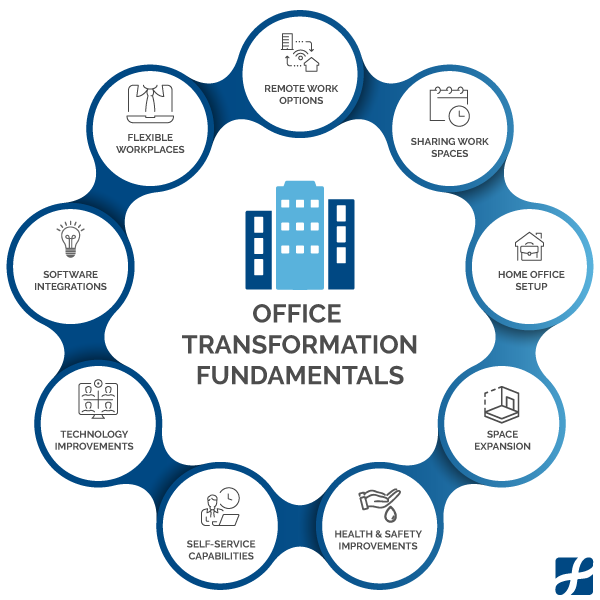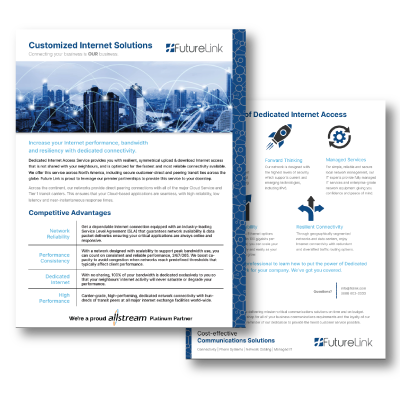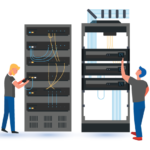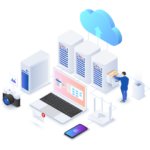Your Office Transformation Guide
Traditional workplaces have experienced rapid change as of late. Coupled with flexible work environments and remote work trends, businesses are challenged to reimagine how they choose to design their workplace infrastructure.
Work is no longer a physical place anymore.
For many businesses that lack the required infrastructure, emulating a model that provides ‘modern team’ flexibility can be quite challenging. With proper guidance and some technological wherewithal, you can deliver ideal work environments where your team is able to communicate, collaborate, and connect anywhere, from any device, while still maintaining a level of desired productivity.
For many businesses that lack the required infrastructure, emulating a model that provides ‘modern team’ flexibility can be quite challenging. With proper guidance and some technological wherewithal, you can deliver ideal work environments where your team is able to communicate, collaborate, and connect anywhere, from any device, while still maintaining a level of desired productivity.

“Currently, at least 56.8% of teams work remotely at least part time in North America.” — Upwork

Reinventing the traditional workplace.
The barriers between leisure, work, and home are slowly eroding. Individuals are equally as likely to work in the comfort of their home as much as in-office. A recent study from upwork conducted in 2020 discovered approximately 36.2% of North Americans will be working remotely by 2025. This is a significant increase from emerging trends before the pandemic.
Although these trends provide employees with some reprieve, flexible work environments come equipped with their own challenges, specifically in the IT sector. Businesses must find methods to provide full-time remote workers and office personnel the same level of access, while maintaining an optimal level of security. The time is now to reimagine your workspace to meet the needs of your team into the future.
“Consistent Connectivity and Flexible Collaboration are critical components for companies to consider. With a strategic approach, companies deliver great customer experience consistently, while empowering staff to maintain productivity, regardless of location.”
Simon Jones | Sales Engineer
Workspace Options
There are several choices available for modern offices, many of which stem from the traditional in-office setting, temporary on-premise, or fully remote with cloud capabilities. Leaders must determine the best solution based on their business requirements.
We’ve worked on many projects similar to yours.
Everything we do is dedicated to delivering mission-critical communications solutions on time and on budget. We strive to provide a one-stop-shop for all of your business communications requirements and the loyalty of our customers serves as a constant reminder of our dedication to provide the finest customer service possible.

Future Link has provided us with expert 24/7 support for many years, and helped our workforce evolve to work from anywhere.

We’ve dealt with other phone companies which pale in comparison. Future Link worked with us to tailor exactly what we needed, and was professional about it.

Where others let us down, Future Link came to the rescue. They took an existing phone system setup, and made it work the way we wanted it to. The service techs, sales people, and everyone else are fantastic.

Future Link’s expert advice and support helped us grow our telecommunications from a single location to a fully integrated national solution for all our offices, and saved us lots of money along the way.

Future Link is the company to consider when you look for knowledge, reliability, and professional service.

The switch to VoIP handled by Future Link was a most positive experience. From the initial quote to installation and delivery, Future Link asked the right questions delivered as promised. The result was the right solution that suited our needs.

The Future Link team has been reliable and effective in supporting our ongoing growth with timely answers and affordable solutions. I know that I will get the answers I need when brining in their help
Providing a reliable foundation for your organization’s overall communications network.
Ready to get started? Explore Future Communications array of remote work solutions.
Call Sales at (905) 363-0532, or let us know more about your needs and a Future Link’s expert will be in touch. Our experienced representatives can make a personalized recommendation for you, based on your business’ specific situation and requirements.






